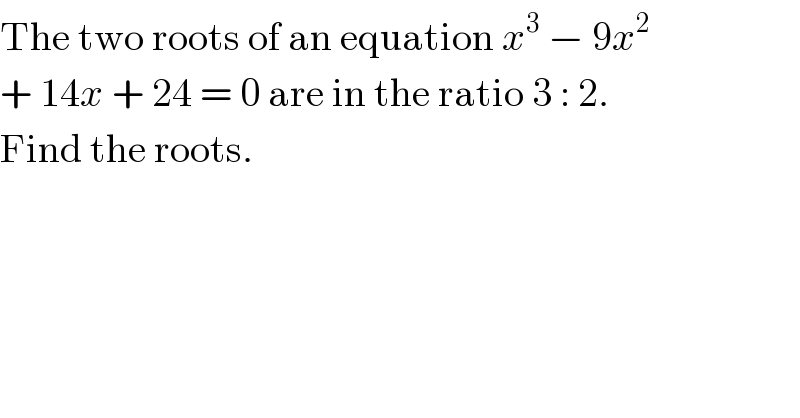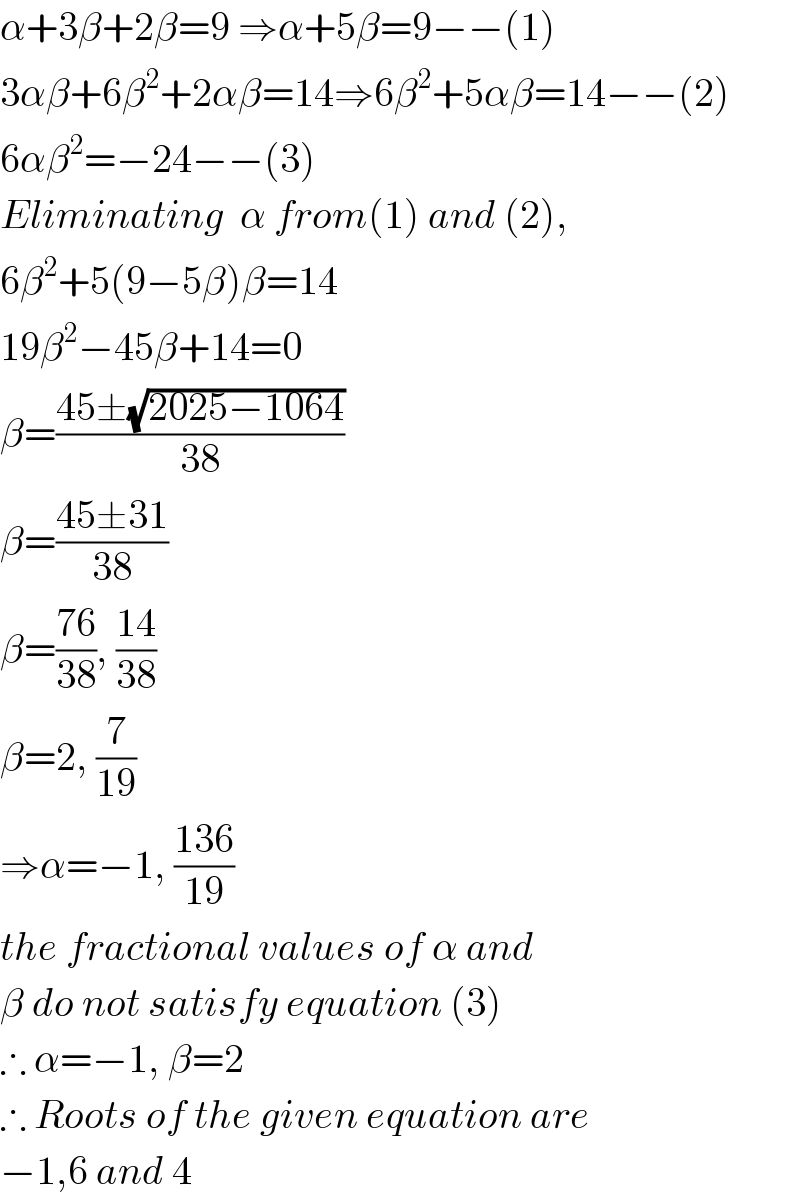
Question Number 20372 by Tinkutara last updated on 26/Aug/17

$$\mathrm{The}\:\mathrm{two}\:\mathrm{roots}\:\mathrm{of}\:\mathrm{an}\:\mathrm{equation}\:{x}^{\mathrm{3}} \:−\:\mathrm{9}{x}^{\mathrm{2}} \\ $$$$+\:\mathrm{14}{x}\:+\:\mathrm{24}\:=\:\mathrm{0}\:\mathrm{are}\:\mathrm{in}\:\mathrm{the}\:\mathrm{ratio}\:\mathrm{3}\::\:\mathrm{2}. \\ $$$$\mathrm{Find}\:\mathrm{the}\:\mathrm{roots}. \\ $$
Answered by $@ty@m last updated on 26/Aug/17

$$\alpha+\mathrm{3}\beta+\mathrm{2}\beta=\mathrm{9}\:\Rightarrow\alpha+\mathrm{5}\beta=\mathrm{9}−−\left(\mathrm{1}\right) \\ $$$$\mathrm{3}\alpha\beta+\mathrm{6}\beta^{\mathrm{2}} +\mathrm{2}\alpha\beta=\mathrm{14}\Rightarrow\mathrm{6}\beta^{\mathrm{2}} +\mathrm{5}\alpha\beta=\mathrm{14}−−\left(\mathrm{2}\right) \\ $$$$\mathrm{6}\alpha\beta^{\mathrm{2}} =−\mathrm{24}−−\left(\mathrm{3}\right) \\ $$$${Eliminating}\:\:\alpha\:{from}\left(\mathrm{1}\right)\:{and}\:\left(\mathrm{2}\right), \\ $$$$\mathrm{6}\beta^{\mathrm{2}} +\mathrm{5}\left(\mathrm{9}−\mathrm{5}\beta\right)\beta=\mathrm{14} \\ $$$$\mathrm{19}\beta^{\mathrm{2}} −\mathrm{45}\beta+\mathrm{14}=\mathrm{0} \\ $$$$\beta=\frac{\mathrm{45}\pm\sqrt{\mathrm{2025}−\mathrm{1064}}}{\mathrm{38}} \\ $$$$\beta=\frac{\mathrm{45}\pm\mathrm{31}}{\mathrm{38}} \\ $$$$\beta=\frac{\mathrm{76}}{\mathrm{38}},\:\frac{\mathrm{14}}{\mathrm{38}} \\ $$$$\beta=\mathrm{2},\:\frac{\mathrm{7}}{\mathrm{19}} \\ $$$$\Rightarrow\alpha=−\mathrm{1},\:\frac{\mathrm{136}}{\mathrm{19}} \\ $$$${the}\:{fractional}\:{values}\:{of}\:\alpha\:{and} \\ $$$$\beta\:{do}\:{not}\:{satisfy}\:{equation}\:\left(\mathrm{3}\right) \\ $$$$\therefore\:\alpha=−\mathrm{1},\:\beta=\mathrm{2} \\ $$$$\therefore\:{Roots}\:{of}\:{the}\:{given}\:{equation}\:{are} \\ $$$$−\mathrm{1},\mathrm{6}\:{and}\:\mathrm{4} \\ $$
Commented by Tinkutara last updated on 26/Aug/17

$$\mathrm{Thank}\:\mathrm{you}\:\mathrm{very}\:\mathrm{much}\:\mathrm{Sir}! \\ $$
Answered by ajfour last updated on 26/Aug/17
![let roots be 3r,2r,γ 5r+γ=9 ; 6r^2 +5γr=14 ; 6r^2 γ=−24 ⇒ r^2 γ=−4 5r^3 +r^2 γ =9r^2 ⇒ 5r^3 −9r^2 −4=0 ...(i) from first two equations, we get ⇒ 5r^2 +(((14−6r^2 )/5))=9r 19r^2 −45r+14=0 19r^2 −38r−7r+14=0 (19r−7)(r−2)=0 r=2 satisfies (i) if r=(7/(19)), then 5((7/(19)))^3 −9((7/(19)))^2 −4=(((7)^2 )/((19)^3 ))[35−171] ≠0 . So r≠(7/(19)) r=2, α=3r=6 , β=2r=4 γ=9+5r =9−10=−1 roots are 6, 4, −1 .](Q20378.png)
$${let}\:{roots}\:{be}\:\mathrm{3}{r},\mathrm{2}{r},\gamma \\ $$$$\mathrm{5}{r}+\gamma=\mathrm{9}\:\:;\:\:\mathrm{6}{r}^{\mathrm{2}} +\mathrm{5}\gamma{r}=\mathrm{14}\:; \\ $$$$\mathrm{6}{r}^{\mathrm{2}} \gamma=−\mathrm{24}\:\Rightarrow\:\:\:{r}^{\mathrm{2}} \gamma=−\mathrm{4} \\ $$$$\:\:\:\:\mathrm{5}{r}^{\mathrm{3}} +{r}^{\mathrm{2}} \gamma\:=\mathrm{9}{r}^{\mathrm{2}} \\ $$$$\Rightarrow\:\:\mathrm{5}{r}^{\mathrm{3}} −\mathrm{9}{r}^{\mathrm{2}} −\mathrm{4}=\mathrm{0}\:\:\:...\left({i}\right) \\ $$$${from}\:{first}\:{two}\:{equations},\:{we}\:{get} \\ $$$$\Rightarrow\:\:\:\mathrm{5}{r}^{\mathrm{2}} +\left(\frac{\mathrm{14}−\mathrm{6}{r}^{\mathrm{2}} }{\mathrm{5}}\right)=\mathrm{9}{r} \\ $$$$\:\:\:\:\:\:\:\:\mathrm{19}{r}^{\mathrm{2}} −\mathrm{45}{r}+\mathrm{14}=\mathrm{0} \\ $$$$\:\:\:\:\:\:\:\:\mathrm{19}{r}^{\mathrm{2}} −\mathrm{38}{r}−\mathrm{7}{r}+\mathrm{14}=\mathrm{0} \\ $$$$\:\:\:\:\:\:\:\:\left(\mathrm{19}{r}−\mathrm{7}\right)\left({r}−\mathrm{2}\right)=\mathrm{0} \\ $$$$\:\:{r}=\mathrm{2}\:{satisfies}\:\left({i}\right) \\ $$$$\:{if}\:\:\:\:\:{r}=\frac{\mathrm{7}}{\mathrm{19}},\:{then} \\ $$$$\mathrm{5}\left(\frac{\mathrm{7}}{\mathrm{19}}\right)^{\mathrm{3}} −\mathrm{9}\left(\frac{\mathrm{7}}{\mathrm{19}}\right)^{\mathrm{2}} −\mathrm{4}=\frac{\left(\mathrm{7}\right)^{\mathrm{2}} }{\left(\mathrm{19}\right)^{\mathrm{3}} }\left[\mathrm{35}−\mathrm{171}\right] \\ $$$$\:\:\:\neq\mathrm{0}\:\:.\:{So}\:\:{r}\neq\frac{\mathrm{7}}{\mathrm{19}} \\ $$$$\:\:\:\:{r}=\mathrm{2},\:\:\:\alpha=\mathrm{3}{r}=\mathrm{6}\:,\:\beta=\mathrm{2}{r}=\mathrm{4} \\ $$$$\:\:\:\gamma=\mathrm{9}+\mathrm{5}{r}\:=\mathrm{9}−\mathrm{10}=−\mathrm{1} \\ $$$${roots}\:{are}\:\mathrm{6},\:\mathrm{4},\:−\mathrm{1}\:. \\ $$
Commented by Tinkutara last updated on 26/Aug/17

$$\mathrm{Thank}\:\mathrm{you}\:\mathrm{very}\:\mathrm{much}\:\mathrm{Sir}! \\ $$
Commented by $@ty@m last updated on 26/Aug/17

$${why}\:{r}\:{is}\:{an}\:{integer}? \\ $$$${Unless}\:{you}\:{justify}\:{it}, \\ $$$$\mathrm{3}×\frac{\mathrm{7}}{\mathrm{19}}\:{and}\:\mathrm{2}×\frac{\mathrm{7}}{\mathrm{19}\:}\:{are}\:{also}\:{possible}\:{roots}. \\ $$
Commented by ajfour last updated on 26/Aug/17

$${yes},\:{you}\:{are}\:{right}. \\ $$
